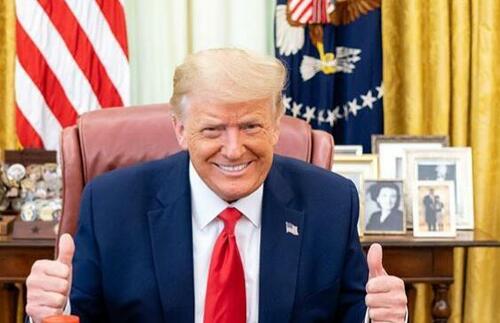
Authored by Jim Lee via RealClearPennsylvania,
Currently, both the national climate and the polling seems to point to a Trump victory in November. For instance, according to polling averages , only 28% of Americans say the country is going in the right direction, compared to 61% who say it’s on the wrong track. Why is this important? Because wrong track voters are more apt to vote for the party out of power – i.e., the Trump campaign – than the party “in power.”
Second, President Joe Biden’s average approval rating is still at a dismal 41% nationally, with a higher 56% of Americans saying they disapprove of his job performance. Why is this important? Because if Americans are unhappy with the president’s job performance, they theoretically should be less likely to vote for another four years of his administration with a vote for the Harris campaign. And remember, when Kamala Harris was asked on a national network television program just recently if she would have done anything different than Biden, she couldn’t answer. In other words, she seems to have unwittingly conceded that she represents another four years of a Biden presidency.
Another reason the political climate seems to favor Republicans at the current time has to do with how Americans are self-identifying in polls. According to national polling, in October 2016, the country self-identified as Democrat by a 3-point margin over Republicans. In October 2020, the country self-identified as Democrat by a higher 6-point margin. But in September of this year, just last month, new polling showed Republicans with a 1-point lead over Democrats on party self-identification. This could prove important because it seems to suggest that more Americans are aligned with the GOP brand than the Democrats – another good sign for the Trump campaign.
Moreover, the current polling has shifted in Trump’s favor both nationally and in critical battleground states. For instance, the RCP average of national polls now shows Trump with a 48.4 to 48.3% lead – just one tenth of a percent difference, but still leaning Trump. This is a big deal because the national popular vote has favored Harris for months, but now has shifted in Trump’s favor. This could be a sign of which way the political winds are blowing. Plus, polling averages currently show that Trump leads in all seven battleground states, including Pennsylvania (.6 percent lead), Michigan (.2 points), Wisconsin (.2 points), Arizona (1.5 points), North Carolina (.8 points), Georgia (2.2 points) and Nevada (.7 points). These are RCP averages as of October 26.
In Pennsylvania, Trump’s lead is significant when you consider that on that day in 2020, Biden led in the RCP averages in Pennsylvania by 4.8%; Biden of course went on to eek out a narrow margin over Trump by only 1.2%. Back in 2016 at this time, Hillary Clinton led in the RCP averages by 4.3 points, only to lose to Trump by a razor-thin, 48.58 to 47.85 margin on Election Day (or 44,292 votes).
So, are we on the cusp of a landslide (Electoral College) victory for Trump? No one knows for sure, but it could happen. In Pennsylvania, our latest poll shows a 46% to 45.8% statistical tie between Trump and Harris (Harris leading by .2 percentage points). This poll was conducted October 18-22 with a sample size of 500 likely voters. But there is plenty of good news for Trump in this poll.
For instance, Trump looks poised to overperform his 2020 numbers with Republicans. In the current survey, Trump is winning Republicans by an 89.4% to 3.7% margin over Harris. Why is this important? In 2020, Trump lost 8% of the GOP vote to Biden – a huge setback in a state where Democrats outnumber Republicans. More importantly, Trump is doing better with Independents in the current survey, currently leading them 43.9% to 36.4%. In 2020, Biden carried Independents by a 52:44 margin according to CNN exit polls. If Trump wins Independents in Pennsylvania, which constitute about 16% of the electorate and are technically the fastest growing cohort of the voter registration rolls, he will likely win the Keystone State.
And the political issues currently favor a Trump victory in terms of what is influencing people’s vote choices. For instance, in our Pennsylvania survey, 45% say inflation and the economy is the top issue that will influence peoples’ votes for a candidate, while immigration is second (at 32%). No other issue polls higher. Inflation/economy voters are breaking for Trump by a 57.4% to 35.4% margin. Immigration voters favor Trump by a whopping 72.7% to 17.4% margin. So, if voters go to the polls thinking about inflation, the economy and illegal immigration, Trump is likely to win. Lower ranking issues like protecting democracy, reproductive rights, and healthcare access all favor the Harris narrative.
Yet despite all these factors pointing in Trump’s direction, our polling still shows a statistical tie, so Harris can’t be counted out. In the poll, there are some red flags for Trump. For instance, voters who say they already cast early ballots favor Harris by a 53.9% to 37.1% margin. This means Harris has the edge in early returns with absentee and mail in ballots. Plus, Trump doesn’t seem to be getting much traction with Hispanic/Latino voters, which make up about 8% of the state’s electorate and are a fast-growing cohort in suburban areas like Lancaster, Reading, Allentown and Wilkes-Barre/Scranton media markets. In the current survey, Harris leads Trump with Latino voters 76.7% to 20.0%. This suggests an underperformance for Trump when you consider that Trump got 27% of the Latino vote in 2020 according to exit polls. In addition, in a separate poll we recently conducted in the hotly contested 10th congressional district election (between GOP incumbent U.S. Rep. Scott Perry and Democratic challenger Janelle Stelson), Harris actually leads Trump by a 46:41 margin – a reversal from a 4-point Trump victory in this same district in 2020. So, Trump seems be underperforming in some Mid-state counties, which are a must win area for him when you consider that our polling shows Trump will lose the vote-rich Philadelphia suburban collar counties, plus the state’s two major urban centers of Allegheny and Philadelphia counties. Let’s not forget that in 2020, Biden carried the Keystone State but only by winning 13 of Pennsylvania’s 67 counties – a highly surgical approach to victory.
So, the current survey seems to suggest a very close race on Election Day in a very pivotal battleground state. Turnout could be the deciding factor in determining the outcome. This is because Pennsylvania is almost a 50:50 state in voter registration since the GOP has narrowed the voter registration edge to fewer than a 300,000 vote-difference, or a current 44% Democrat to 40% GOP margin; independents and other third-party voters make up the remaining 16%. Exit polls in 2020 showed a +1 percent margin for GOP versus Democrats in party self-Identification. In the current poll, Trump is winning Republicans 89.4% to 3.7% over Harris, while Harris is winning Democrats 90.8% to 3.2% over Trump. So, both candidates seem to be doing equally well in their respective bases of support. This means it’s hard to tell if the “never Trump” campaign narrative is getting real traction or is simply a red herring. This means whichever candidate gets more of their voters to the polls will likely be the victor. Other states will see similar trend lines since states like Arizona, Nevada, and Wisconsin are also states where Republicans and Democrats are relatively equal in voter registration. Turnout will play a critical role in this election, and the party that gets their vote out could have the edge on Election Day.
Loading…
Originally Posted at; https://www.zerohedge.com//






